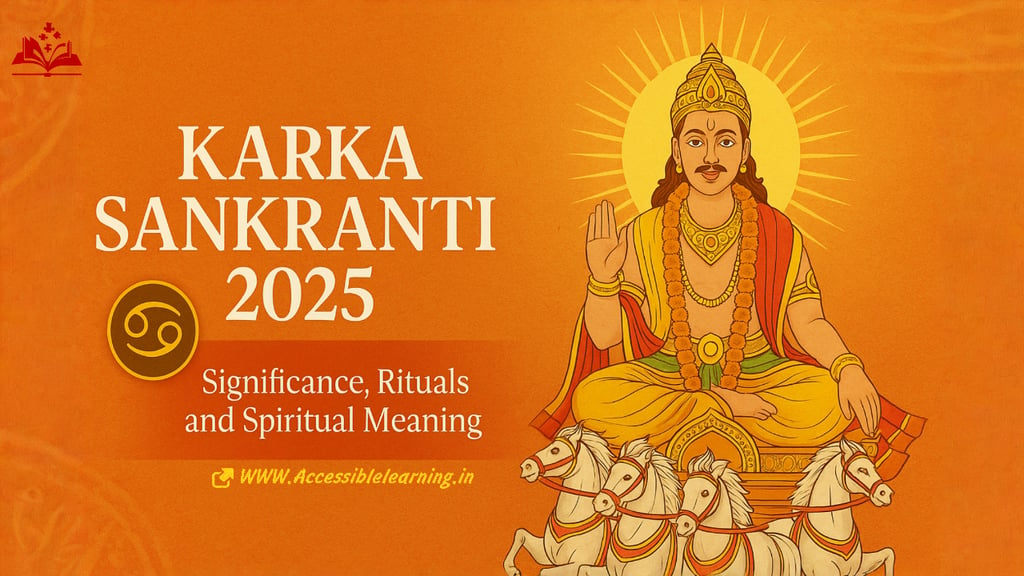
Karka Sankranti 2025: Significance, Rituals, and Spiritual Meaning
Karka Sankranti 2025 marks the Sun’s entry into Cancer (Karka Rashi) and the beginning of Dakshinayana. Discover its spiritual meaning, rituals, significance in Ayurveda, and what to do on this sacred day.
CULTURE/TRADITIONEDUCATION/KNOWLEDGEINDIA/BHARATCELEBRATION/FESTIVALS
Keshav Jha
7/11/20253 min read


What is Karka Sankranti?
Karka Sankranti, also known as Dakshinayana Sankranti, marks the celestial event when the Sun enters Karka Rashi (Cancer zodiac). In 2025, Karka Sankranti falls on Monday, July 16. This event signals the beginning of Dakshinayana, the southern journey of the Sun in Hindu cosmology.
It is one of the 12 Sankrantis observed annually and holds immense astrological, spiritual, and seasonal importance, especially in the Vedic and Ayurvedic calendars.
Spiritual & Astrological Significance of Karka Sankranti
The Shift to Dakshinayana
Karka Sankranti initiates the six-month period of Dakshinayana, often referred to as the "night of the gods" (in contrast to Uttarayana, the "day of the gods"). This phase is known for:
Increased spiritual introspection
Favorable period for ancestral rituals and Pitra Karma
Reduced external activity and more inward reflection
In Vedic astrology, this transition also marks a shift in solar energy—moving from masculine Surya energy to more nurturing, cooling lunar energy governed by the Moon (Cancer's ruling planet).
Rituals & Traditions Observed on Karka Sankranti
Holy Dips & Snan (Bathing Rituals)
Taking a sacred dip in rivers like the Ganga, Yamuna, Godavari, or Narmada is believed to cleanse sins and promote mental clarity.
Charity (Daan) & Feeding the Poor
It is a day known for punya (meritorious deeds). People offer:
Clothes
Grains (especially rice and wheat)
Ghee
Cows or gold (as per capacity)
Seasonal fruits
Donating food to Brahmins and cows is highly auspicious.
Puja & Mantra Chanting
Many people worship Surya Ji (Sun God) by chanting the Gayatri Mantra and Aditya Hridaya Stotra. Temples of Surya and Shiva conduct special pujas.
Observing Fasts & Vratas
Some devotees observe fasts and engage in self-purification practices. It is considered a powerful time to start Sawan Somwar Vrats dedicated to Shiv Ji (since Sawan month often coincides).

Connection to the Monsoon & Seasonal Change
Karka Sankranti is not just a religious marker—it also signifies a climatic transition, especially in India:
Marks the peak of the monsoon season
Associated with growth, fertility, and nourishment
Farmers begin preparations for Kharif crops
As Cancer is a watery sign and the Sun is a fiery planet, this transition also symbolizes the balance of fire and water energies, playing a role in Ayurveda and health cycles.
Karka Sankranti & Ayurveda
In Ayurvedic wisdom, this period leads to an increase in vata and pitta dosha, and thus it is advised to:
Eat light, cooling, and sattvic foods
Avoid overexertion
Include herbs like neem, tulsi, amla, and ghee in the diet
Focus on meditation and grounding practices
Do’s & Don’ts on Karka Sankranti
Do’s
Wake up early and bathe before sunrise.
Perform Surya Arghya (water offering to the sun).
Donate food, clothes, and essentials to the needy.
Visit temples and meditate for inner peace.
Don’ts
Avoid starting new ventures (considered inauspicious).
Refrain from negative emotions and heated debates.
Avoid consuming tamasic foods like meat, onion, and garlic.
Karka Sankranti 2025 Muhurat (Timing)
Date: Wednesday, July 16, 2025
Punya Kaal Muhurat: 07:05 AM to 12:35 PM (IST)
Mahapunya Kaal Muhurat: 07:05 AM to 09:00 AM (IST)

Why Karka Sankranti Is Not Celebrated Like Makar Sankranti?
Unlike Makar Sankranti (the sun's entry into Capricorn), Karka Sankranti doesn't involve grand festivities. This is because
It marks the beginning of Dakshinayana, considered less favorable for worldly activities.
It is more about inner purification and quiet reflection than outward celebration.
However, in many parts of India, like Odisha, Maharashtra, Tamil Nadu, and Kerala, people do observe it with simple rituals and reverence.
Karka Sankranti may not be celebrated with pomp, but its spiritual and cosmic essence is profound. It encourages us to slow down, look inward, and embrace the cycle of nourishment, balance, and humility. As the Sun journeys southward, we are reminded of the divine rhythm of nature—and our place within it.
FAQs
Q. Is Karka Sankranti the same as Dakshinayana?
Yes, Karka Sankranti marks the beginning of Dakshinayana, the southern journey of the Sun.
Q. Can I start new projects on Karka Sankranti?
Traditionally, it is not considered a favorable day for starting new ventures. Focus on charity, prayers, and self-discipline.
Q. Is Karka Sankranti important for Pitru rituals?
Yes, the Dakshinayana period is highly suitable for ancestral rituals, especially Shraddha and Tarpan.
Q. Why is there no festival on Karka Sankranti?
Because it marks a more inward, spiritual time of the year—unlike Makar Sankranti, which opens the doors to auspicious events.
Subscribe To Our Newsletter
All © Copyright reserved by Accessible-Learning Hub
| Terms & Conditions
Knowledge is power. Learn with Us. 📚


